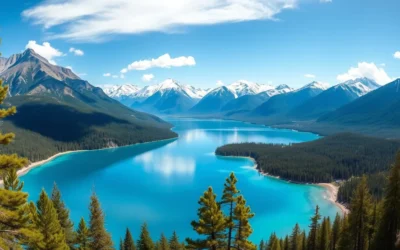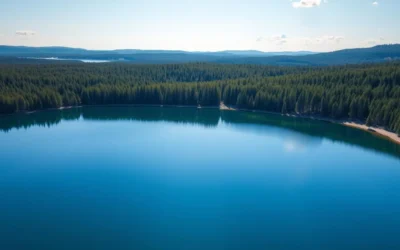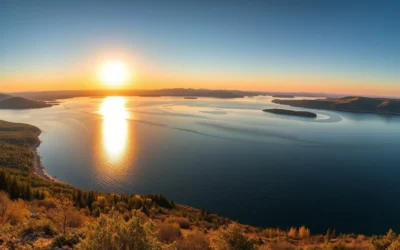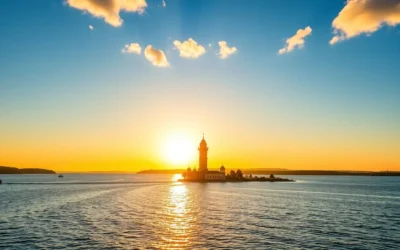Lake Baikal holds an astonishing 20% of the world’s unfrozen freshwater—enough to supply Earth’s entire population for 50 years. This ancient rift lake in Siberia isn’t just the deepest lake on our planet at 1,642 m (5,387 ft), it’s also home to over 3,700 species of plants and animals, with nearly 80% found nowhere else on Earth. As you plan your journey to this UNESCO World Heritage site, prepare to be amazed by its crystal-clear waters, stunning landscapes, and the unique experiences that await you in this remote corner of Russia.
Getting There & Planning Your Journey
The vast expanse of Lake Baikal stretches 636 km (395 mi) from north to south
Reaching Lake Baikal requires some planning, but the journey is well worth the effort. The most common gateway is through Irkutsk, a city often called the “Paris of Siberia,” located on the western shore of the lake.
By Air
International travelers typically fly into Moscow or St. Petersburg first, then take a domestic flight to Irkutsk International Airport. The flight from Moscow to Irkutsk takes approximately 5-6 hours. For the eastern shore, you can fly to Ulan-Ude, which is about 100 km (62 mi) from the lake.
Find the Best Flights to Lake Baikal
Compare prices and book your flights to Irkutsk or Ulan-Ude to begin your Lake Baikal adventure.
By Train
The legendary Trans-Siberian Railway passes along the southern shore of Lake Baikal, offering a scenic and authentic Russian travel experience. The journey from Moscow to Irkutsk takes about 3.5 days, with the train making a spectacular run along the lake’s shore. This historic railway journey is an attraction in itself.
Visa Requirements
Most international visitors require a visa to enter Russia. Apply for your tourist visa at least one month before your planned trip. You’ll need an invitation letter, which can be obtained through your hotel or a travel agency specializing in Russian tourism.
Best Time to Visit Lake Baikal
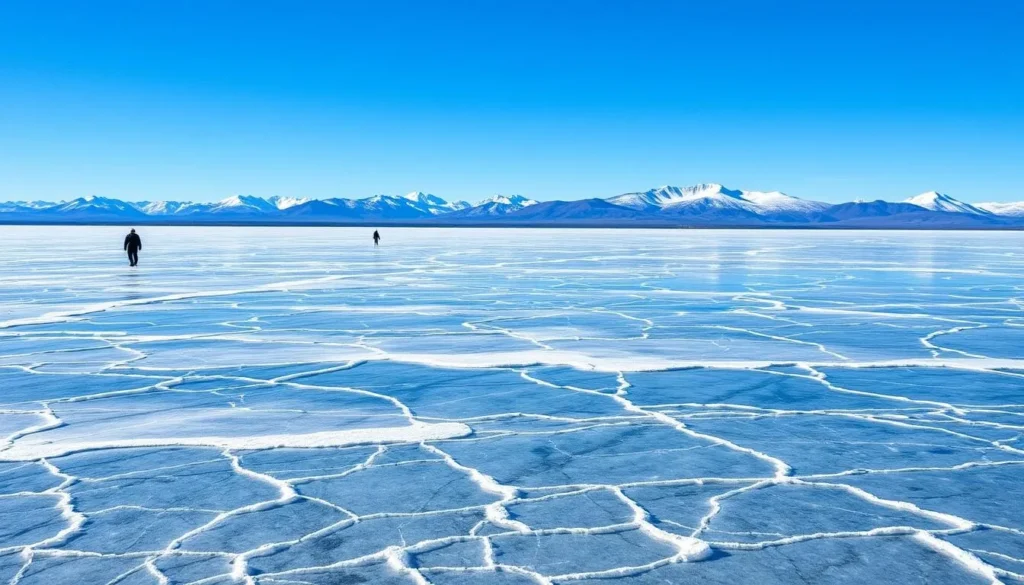
The lake’s famous clear ice creates a magical winter landscape from January through March
Lake Baikal offers dramatically different experiences depending on when you visit. Each season has its unique charm, but some are more accessible and comfortable than others.
| Season | Months | Weather | Activities | Recommendation |
| Winter | Late January – March | -15°C to -25°C (5°F to -13°F) | Ice skating, ice fishing, dog sledding, ice caves | Highly Recommended |
| Spring | April – May | 0°C to 15°C (32°F to 59°F) | Hiking, wildlife viewing, fewer tourists | Good for budget travelers |
| Summer | June – August | 15°C to 25°C (59°F to 77°F) | Swimming, hiking, boating, camping | Highly Recommended |
| Autumn | September – October | 5°C to 15°C (41°F to 59°F) | Hiking, photography, fall colors | Good for photographers |
| Late Autumn | November – December | -10°C to 0°C (14°F to 32°F) | Limited as ice is forming but not stable | Not Recommended |
Recommended Seasons
For winter enthusiasts, late February to early March offers the perfect combination of stable ice conditions and slightly milder temperatures. Summer travelers should aim for July and August when the water is warm enough for swimming in certain areas.
Seasons to Avoid
November through early January is generally not recommended as the ice is forming but not yet thick enough for winter activities, while the weather is too cold for comfortable summer activities. May can be muddy as the snow melts, and some areas may be difficult to access.
Getting Around Locally

Local UAZ vehicles are the preferred transport for exploring Olkhon Island’s rugged terrain
Lake Baikal is enormous, stretching 636 km (395 mi) from north to south. Getting around requires some planning, especially since public transportation is limited in many areas.
Local Transport Options
Explore Lake Baikal at Your Own Pace
Rent a reliable 4WD vehicle to discover hidden gems around Lake Baikal.
Distance Between Key Locations
Keep in mind that distances around Lake Baikal are vast. It would take more than 24 hours of continuous driving to circumnavigate the entire lake. Plan your itinerary to focus on specific regions rather than trying to see everything in one trip.
Where to Stay

Traditional wooden guesthouses offer authentic accommodation experiences on Olkhon Island
Accommodation options around Lake Baikal range from comfortable hotels in cities to rustic guesthouses in remote villages. Where you stay will greatly impact your experience, so choose based on the activities you plan to enjoy.
Popular Areas to Stay
Accommodation Types
Tourist bases (“baza”) are a popular accommodation option around Lake Baikal. These range from basic wooden cabins with shared facilities to comfortable complexes with private bathrooms and restaurants. Many include meals in their rates, which is convenient given the limited dining options in remote areas.
Find Your Perfect Lake Baikal Stay
Browse and book accommodations around Lake Baikal, from city hotels to lakeside guesthouses.
Booking Tips
Accommodations in popular areas like Olkhon Island and Listvyanka fill up quickly during peak summer months (July-August) and the ice season (February-March). Book at least 3-4 months in advance for these periods. Many smaller guesthouses don’t have online booking systems, so you may need to email or call directly.
Dining & Local Cuisine

Smoked omul, a whitefish endemic to Lake Baikal, is a must-try local delicacy
The cuisine around Lake Baikal blends Russian, Siberian, and Buryat influences, creating a unique culinary experience. Fresh fish from the lake features prominently on local menus, alongside hearty Siberian and Buryat specialties.
Must-Try Local Dishes
Where to Eat
Dining options vary greatly depending on your location. Cities like Irkutsk offer everything from upscale restaurants to casual cafes, while remote areas may have limited choices.
Dining Tips
In remote areas, many accommodations offer full board (three meals a day), which is often the most convenient option. If you’re planning to stay in isolated locations, consider bringing some snacks and supplies. During summer, local markets sell fresh berries, including wild strawberries and blueberries, which make for delicious natural treats.
Attractions, Sightseeing & Activities

Shamanka Rock (Shaman Rock) on Olkhon Island is one of Lake Baikal’s most iconic landmarks
Lake Baikal offers a wealth of natural and cultural attractions that will keep you busy regardless of when you visit. From stunning landscapes to unique wildlife, there’s something for every type of traveler.
Top Natural Attractions
Discover the Best of Lake Baikal
Book guided tours and activities to experience Lake Baikal’s top attractions with knowledgeable local guides.
Seasonal Activities
Winter Activities (January-March)
- Ice skating on the transparent ice
- Ice fishing with local guides
- Dog sledding across the frozen lake
- Exploring ice caves and grottos
- Snowmobiling adventures
- Winter photography of ice formations
- Visiting hot springs surrounded by snow
Summer Activities (June-August)
- Hiking the Great Baikal Trail
- Swimming in designated areas
- Boat tours around the lake
- Kayaking along the shoreline
- Camping on the beaches
- Fishing for local species
- Wildlife watching (including Baikal seals)

Ice skating on Lake Baikal’s crystal-clear frozen surface is a unique winter experience
Recommended Itineraries
Given the vast size of Lake Baikal, it’s best to focus on specific regions rather than trying to see everything in one trip. Here are some suggested itineraries:
Museums, Cultural Spots & Festivals

Buryat cultural festivals showcase the rich traditions of the indigenous people of the Baikal region
The Lake Baikal region is rich in cultural heritage, with influences from Russian, Buryat, and other indigenous cultures. Museums, cultural centers, and festivals offer insights into the region’s fascinating history and traditions.
Museums and Cultural Sites
Cultural Experiences
Immerse yourself in local culture through these authentic experiences:
Festivals and Events
Timing your visit to coincide with local festivals can add a special dimension to your Lake Baikal experience:
Sports, Nature & Outdoor Experiences

The Great Baikal Trail offers spectacular hiking opportunities with stunning lake views
Lake Baikal is a paradise for outdoor enthusiasts and nature lovers. The pristine environment offers countless opportunities for adventure and exploration throughout the year.
Hiking and Trekking
The Great Baikal Trail (GBT) is a developing network of hiking trails around the lake. While not yet complete, several sections are well-maintained and marked:
Water Activities
During the summer months, Lake Baikal offers various water-based activities:
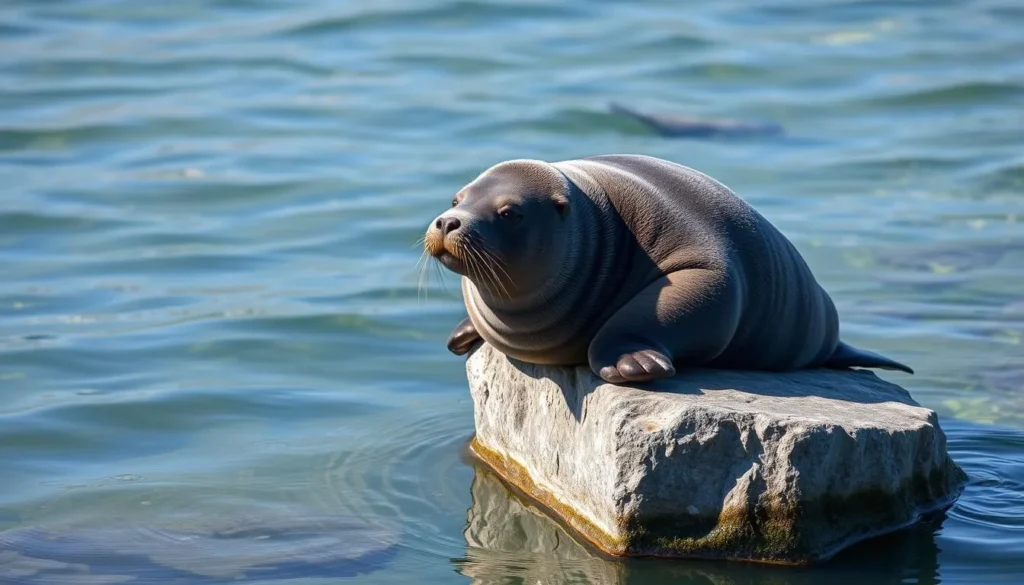
The Baikal seal (nerpa) is the only exclusively freshwater seal species in the world
Wildlife Watching
Lake Baikal is home to unique wildlife, including:
Winter Sports
From late January to early April, Lake Baikal transforms into a winter wonderland offering unique activities:
Experience Lake Baikal’s Natural Wonders
Book guided outdoor adventures and wildlife tours with experienced local guides.
Safety, Etiquette & Local Customs

Colorful prayer flags mark sacred sites around Lake Baikal, particularly in Buryat areas
Visiting Lake Baikal safely and respectfully requires understanding local conditions, customs, and environmental concerns. Here are some important guidelines to ensure a positive experience for both visitors and locals.
Safety Considerations
Cultural Etiquette
The Baikal region is home to diverse cultures, including Russian and indigenous Buryat communities. Respecting local customs will enhance your experience:
Environmental Responsibility
Lake Baikal is a UNESCO World Heritage Site with a fragile ecosystem facing various environmental challenges:
Practical Travel Tips

Lake Baikal offers spectacular photography opportunities, especially during sunrise and sunset
These practical tips will help you navigate the unique challenges and make the most of your Lake Baikal adventure.
Language
English is not widely spoken outside major cities and tourist centers. Learning a few basic Russian phrases will greatly enhance your experience. Consider downloading an offline translation app like Google Translate with the Russian language pack. In Buryat areas, some locals speak Buryat as their first language, though Russian is universally understood.
Money Matters
Connectivity
Cell phone coverage is good in cities and larger villages but can be spotty or nonexistent in remote areas. Major Russian mobile operators (MTS, Beeline, Megafon) provide service around the lake. Consider purchasing a local SIM card for better coverage and data rates. Many accommodations offer Wi-Fi, though connection speeds may be slower than you’re used to.
Packing Essentials
Summer Packing List
- Lightweight, quick-dry clothing
- Warm layers (evenings can be cool)
- Sturdy walking shoes or hiking boots
- Sun protection (hat, sunglasses, sunscreen)
- Insect repellent
- Swimwear (for brave swimmers!)
- Rain jacket
- Basic first aid kit
Winter Packing List
- Thermal base layers
- Heavy winter jacket
- Insulated waterproof boots
- Warm hat, scarf, and gloves
- Ice grippers for shoes
- Sunglasses (glare off ice and snow)
- Lip balm and moisturizer
- Hand and foot warmers
Photography Tips
Lake Baikal offers incredible photography opportunities. The clear air and unique landscapes create perfect conditions for stunning shots. In winter, bring extra batteries as cold temperatures drain them quickly. Keep your camera in your jacket when not in use to keep it warm. For summer visits, the “golden hours” around sunrise and sunset provide the most dramatic lighting for landscape photography.
Ready to Experience Lake Baikal?
Start planning your adventure to one of Earth’s most remarkable natural wonders.
Conclusion
Lake Baikal is truly one of Earth’s natural wonders—a place where pristine wilderness, unique wildlife, and rich cultural traditions create an unforgettable travel experience. Whether you’re skating across its crystal-clear ice in winter, hiking along its shores in summer, or immersing yourself in local cultures year-round, Baikal offers adventures that can’t be found anywhere else on the planet. The journey may require more planning than typical destinations, but those who make the effort are rewarded with experiences of extraordinary beauty and authenticity. As you prepare for your Baikal adventure, remember that the lake’s magic lies not just in its superlative statistics, but in the moments of connection—with nature, with local people, and with the ancient spirit of this remarkable place.
The above is subject to change.
Check back often to TRAVEL.COM for the latest travel tips and deals.


